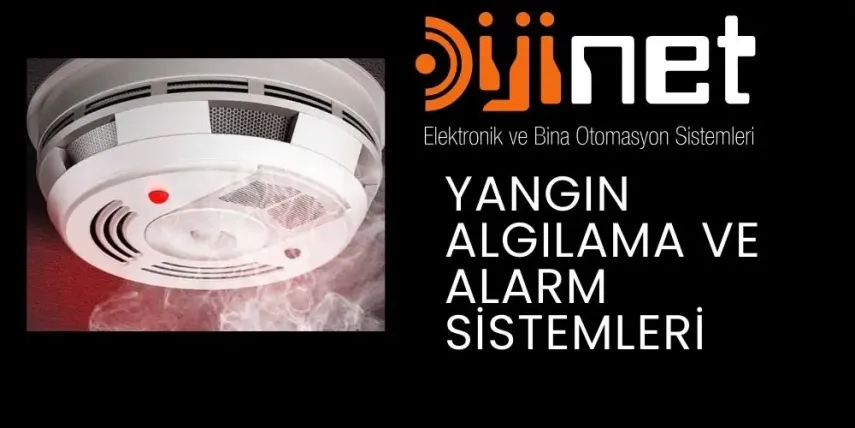The Fire Alarm System is designed to alert us in case of an emergency to enable us to take action to protect ourselves, our personnel, and the public.
Research has shown that 45% of fires occur in residential areas. Furthermore, according to another study, there has been a 49% increase in factory fires. In your country, there have been 587 industrial fires, and unfortunately, many of these have resulted in loss of life. Based on these data, we can see the vital importance of fire alarm and detection systems
Fire detection systems are automatic systems used to detect fire hazards in spaces, buildings, or industrial facilities. Fires are among the most destructive natural disasters and can result in significant loss of life and property. Detecting fires at an early stage to respond quickly plays a crucial role in preventing the spread of fire and minimizing damage.
“Fire detection systems utilize various sensors, detectors, and control panels to detect signs of a fire and alert individuals or fire safety teams. Fire alarm systems typically operate using various detection methods, such as smoke, heat, and flame detectors. These detectors monitor changes in the atmosphere, detecting abnormal conditions and sending signals in the event of an alarm.
Regardless of the detection method, in the event of an alarm trigger, the alarm system will operate to alert people in the building about the fire and facilitate evacuation.”
In this article, we will discuss fire alarm systems, their structures, types, and functions.
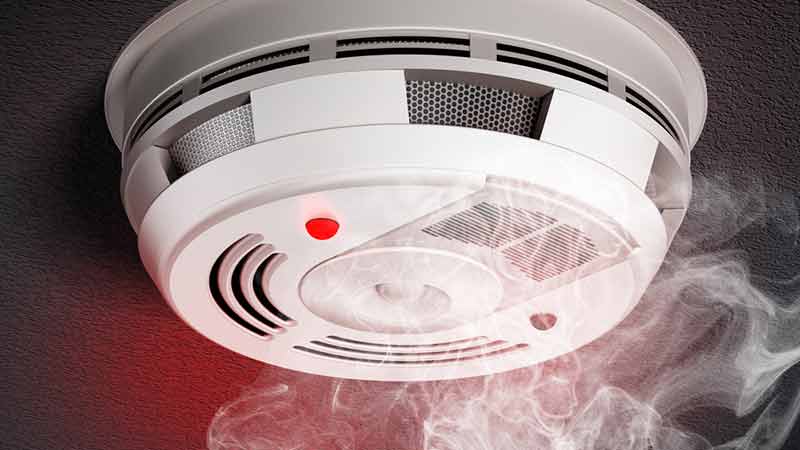
The central device for the fire detector is the Fire Alarm Control Panel. All detectors connect their signals to this panel and provide status indicators to users.
What is a Fire Alarm System?
A fire alarm system is a safety measure that detects the threat of fire in a space, alerting people and notifying firefighting teams. Fire alarm systems are a component of detection systems and typically aim to keep individuals within a facility or building safe. This ensures that living spaces can provide their services safely.
Fire alarm systems are commonly used, especially in large facilities, shopping malls, hotels, hospitals, and industrial facilities. These systems provide early warning and rapid response to help minimize loss of life and property. It’s known that fire alarm systems are now supported by next-generation technologies. Therefore, these new-age systems exhibit top-tier performance.
What is the general application area of Fire Alarm and Fire Detection Systems?
Fire alarm and detection systems are devices and software that enable early detection of fires, allowing for rapid intervention. These systems automatically sound an alarm when a fire begins in a specific area or building, enabling quick response. When it comes to the application areas of these systems, a wide range of options is available. Here are the application areas of fire alarm and detection systems:
- Buildings and Residences
- Industrial Facilities
- Transportation Vehicles
- Healthcare Facilities
- Data Centers
Fires typically originate in enclosed spaces and can spread rapidly. Fire alarm systems can be used in all types of structures, from homes to apartment buildings, office buildings, and shopping centers. These systems rapidly alert people for evacuation when a fire breaks out.
In industrial areas such as factories, warehouses, and manufacturing facilities, the potential for fires to cause significant damage is higher. Detection systems provide early warnings in areas where hazardous materials are used or large machinery is present, ensuring worker safety and the protection of facility assets.
Vehicles like trains, airplanes, and ships that embark on long journeys need protection against the risk of fire. Detection systems in such vehicles are used to ensure passenger safety. Hospitals, clinics, and healthcare centers are places where medical equipment and materials are stored. Fire alarm systems in schools, universities, and educational institutions are used to ensure the safety of students and staff.
In healthcare facilities like hospitals, clinics, and nursing homes, detection systems are crucial for ensuring the safety of patients and staff, especially given the limited mobility of patients. Large data centers house sensitive equipment and data. Fires in these centers can result in significant damage. Fire alarm systems, in conjunction with early warning and automatic extinguishing systems, ensure data security.
Large data centers house sensitive equipment and data. Fires in these centers can result in significant damage. Fire alarm systems, in conjunction with early warning and automatic extinguishing systems, ensure data security.
Why Is a Fire Alarm System Important?
Fire alarm systems are an indispensable part of modern security measures, with life-saving features and advantages in property protection. With functions like early warning, rapid response, and ensuring community safety, the use of these systems provides significant benefits both at the individual and societal levels. Thanks to fire alarm systems, it is possible to build a safer future. Remember, investing in fire alarm systems is always a wise decision for your safety and the safety of those around you.
How Does a Fire Alarm System Work?
Fire alarm systems prevent significant damage and loss of life by providing early fire detection and rapid response. These systems, which involve stages such as detection, alarm generation, notification, and automatic intervention, contribute significantly to enhancing safety. Therefore, it is important to seek the advice of experts and ensure regular maintenance when installing a fire alarm system.
Fire alarm systems use various sensors to detect a fire, with two primary sensor types being smoke detectors and heat detectors. During the detection phase, when the fire sensors perceive danger, the process of generating an alarm begins. Typically, audible and visual alerts are used at this stage. When a fire alarm system detects a hazard, it often automatically notifies a central monitoring station or the fire department.
Advanced fire alarm systems can have automatic intervention capabilities. Such systems can activate fire suppression systems when a fire is detected. The fire alarm system can be triggered not only automatically but also manually. In situations where the system hasn’t detected a threat but you sense a potential danger, you can manually trigger the alarm.
Check out our detailed article on How a Fire Alarm System Works.
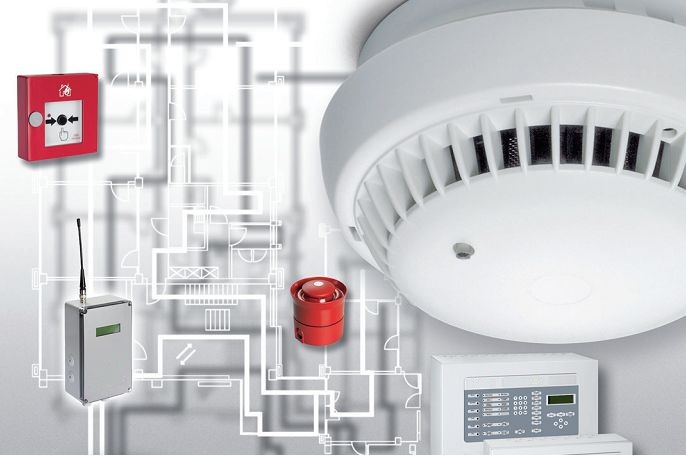
How Is a Fire Alarm System Installed?
Before beginning the installation of a fire alarm system, it is important to assess the risks in your location. Fire alarm systems consist of essential components like detectors, alarm panels, and sirens. Fire detectors trigger the alarm by detecting smoke or changes in temperature. You should mount detectors and other devices in the appropriate areas. It is a good practice to place smoke detectors near the center of the ceiling and temperature detectors close to potential sources of fire.
The alarm panel is a central component that processes signals from the detectors and triggers the alarm when necessary. You should program the panel according to the manufacturer’s instructions. After installing the system, you should test to ensure it is working correctly by testing smoke detectors with smoke and temperature detectors with heat.
Why Is Detection and Alarm System Necessary?
Fire alarm systems offer a range of advantages, including providing safety for life and property, early warning and rapid response, compliance with legal requirements, and meeting insurance needs. These systems help minimize potential fire hazards by offering effective defense, reducing life and property losses. Remember, security is everyone’s right, and detection and alarm systems play a vital role in preserving this right.
Fire Alarm System Connection Diagram
Fire alarm systems are technological systems used to detect and sound alarms in facilities, buildings, and areas that are critically important for security. These systems are created by combining special sensors, detection devices, control panels, and alarm devices.
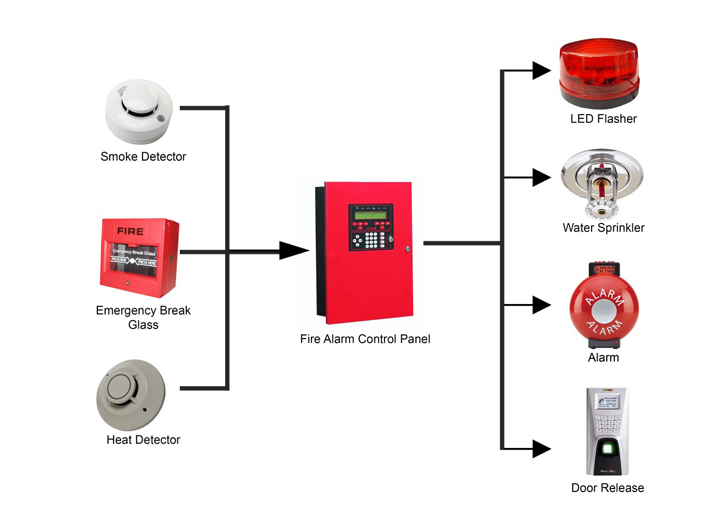
Is a Fire Alarm System Mandatory?
Fire alarm systems are not only crucial for property protection but also for the safety of lives. Early warning can prevent the spread of fire, reduce damage, and most importantly, save lives. Therefore, the use of a fire alarm system should be ensured in compliance with local regulations and legal requirements. Remember, a fire alarm system is not just a requirement; it’s the first step in saving lives.
What are the components that make up the fire alarm and notification system?
When it comes to the components that make up the fire alarm and notification system, various devices come into play. Here are the components typically found in the connection diagram of a basic fire alarm system:
- Fire control panel
- Fire Detectors
- Fire Alarm Buttons
- Fire alarm notification devices
- Fire Alarm Cables
- Fire control panel
Fire Detectors
Fire detectors are devices used to detect the potential threat of a fire in the environment and identify this threat in its early stages. Various types of fire detectors can be used, such as smoke detectors, heat detectors, or flame detectors. Fire detectors automatically activate the alarm system by sensing signs of a fire, enabling rapid response.
Fire Alarm Buttons
Fire alarm buttons are devices used to report a fire hazard in emergency situations. When these buttons are pressed, they send a signal to the alarm center or the appropriate personnel, quickly notifying them of the fire situation. This ensures that emergency teams can respond rapidly to the fire.
Fire Warning Devices
Fire warning devices are used to alert people in the vicinity when a fire is detected. These devices typically provide audible and/or visual alerts. Audible alerts can include sirens, while visual alerts can be provided through flashers or lighting. These devices help people evacuate the area safely during a fire.
Fire Alarm Cables
Fire alarm cables are special cables used to connect different components of fire alarm systems. These cables are designed with a focus on fire resistance and reliability. The goal is to ensure that the cable maintains its structural integrity during a fire, doesn’t disrupt system communication, and maintains safety.
Types of Fire Alarm Detectors
Fire, an unpredictable disaster, can pose significant risks to homes and workplaces. Fires can spread rapidly, causing substantial property damage and even loss of life. Fire safety is of paramount importance in all types of structures. Fire alarm detectors play a critical role in enhancing safety by detecting potential fires and providing early warnings. When it comes to types of fire alarm detectors, the following options are available:
- Heat detectors
- Smoke detectors
- Multi-sensor detectors
- Carbon Monoxide Detector
Heat Detector
Heat detectors are devices designed to identify fire hazards by detecting abnormal temperature increases in the environment. They are typically used as part of fire alarm systems. Heat detectors monitor temperature changes in a room or area and can trigger an alarm when a specific temperature threshold is reached. These detectors are ideal for fires that do not produce smoke, such as increased temperature from a kitchen fire.
Smoke Detector
Smoke detectors are devices that help identify fire hazards by detecting smoke particles in the environment. There are two main types: ionization and optical (photoelectric). Ionization detectors detect smoke by measuring the flow of ionized air particles, while optical detectors use a light source and sensor to detect light scattering caused by smoke. Smoke detectors are often used for rapid fire detection.
Multi-Sensor Detectors
Multi-sensor detectors are devices designed to provide more reliable and effective fire or hazard detection by combining multiple sensing methods. These detectors can often detect both smoke and heat. As a result, they can identify both fast-burning fires and slow-burning fires, providing more accurate and sensitive results tailored to various scenarios.
Carbon Monoxide Detector
Carbon monoxide detectors are devices that detect carbon monoxide (CO), a colorless, odorless, and toxic gas. They help identify leaks that can pose a danger by detecting the presence of this gas. Carbon monoxide can be generated, especially during the combustion of flammable materials or when it leaks from ventilation systems. Carbon monoxide detectors are commonly used in homes, hotels, and industrial facilities. These devices alert users by detecting the presence of the toxic gas and providing audible or visual warnings.
How are Fire Detection and Alarm Systems categorized?
Fire alarm systems are security systems that detect potential fire hazards within a building or area and have the ability to quickly initiate an alarm by identifying these hazards at an early stage. These systems use various technologies, including thermal and optical sensors, smoke detectors, gas sensors, and heat detection devices, to detect fire hazards and automatically trigger an alarm. Fire alarm systems are categorized based on their features and intended use. Here are some of these categories:
Addressable Fire Alarm Systems
Ideal for large and complex areas, these systems have a structure where each addressable detector has its own unique address. This allows for rapid identification of the location when a fire hazard is detected. These systems are easier to manage, but they tend to be slightly more expensive compared to conventional systems.
For More Information: Addressable Fire Detection Systems
Conventional Fire Alarm Systems
Conventional Fire Alarm Systems are typically used in small to medium-sized areas. It can be challenging to determine which detector has been triggered when a fire hazard is detected. They are often preferred due to their simple structures and cost-effectiveness.
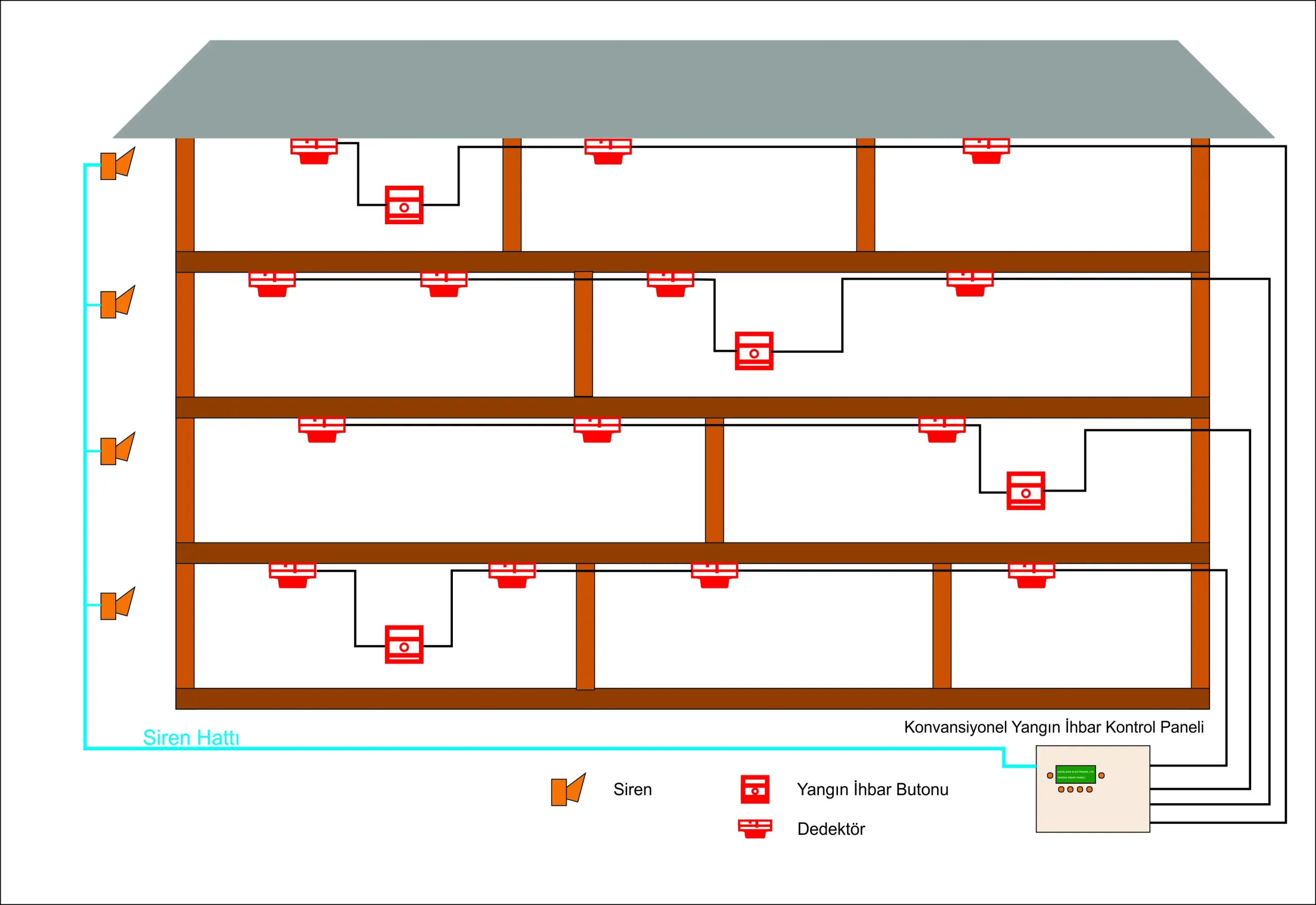
Wireless Fire Alarm Systems
Fire alarm systems can be installed as wired or wireless. In wired systems, detectors and alarm panels are connected via cables, while wireless fire alarm systems establish this connection using wireless communication technologies such as radio frequency or Wi-Fi. Wireless systems offer advantages in terms of installation flexibility.
Smart Fire Detection Systems
These systems offer more features compared to traditional fire alarm systems. They can reduce false alarms and detect real fires more quickly and accurately through the use of artificial intelligence and machine learning techniques.
Dijinet Fire Alarm Products
At Dijinet, we supply and sell Siemens and Teledata branded fire alarm systems.
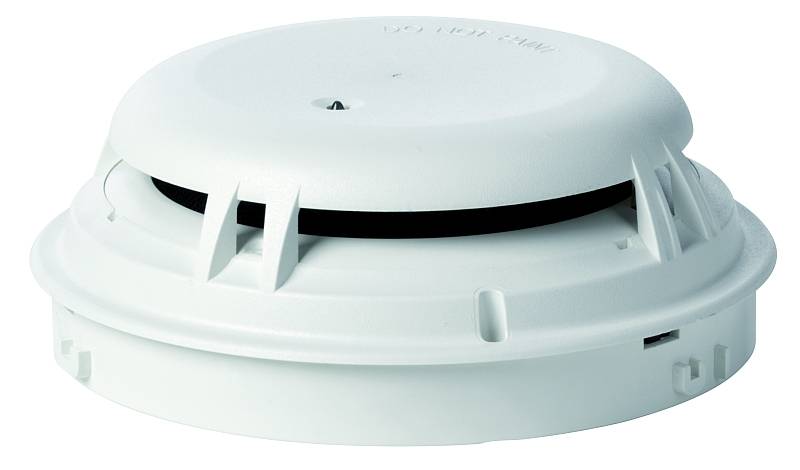
What types of sensors are used in fire detection systems?
Smoke Detectors: Detect smoke density and trigger an alarm if there are signs of smoke.
Heat Detectors: Detect sudden temperature increases and trigger an alarm in high-temperature conditions.
Flame Detectors: Detect visible or infrared light from flames and trigger an alarm in the presence of flames.
Gas Detectors: Detect leaks of gases that could lead to a fire.
Which types of buildings require fire detection systems?
Residential buildings
Commercial buildings
Industrial facilities
Public buildings (schools, hospitals, municipal buildings)
Hotels
Shopping centers
Warehouses
Public entertainment venues
How is the maintenance of fire detection systems performed?
Regular maintenance of fire detection systems ensures that the system continues to function correctly. Maintenance may include the following:
Cleaning and testing of sensors
Battery replacements
Software updates
Checking cable connections
Emergency alarm tests
Maintenance should be conducted regularly by professional fire safety experts and must comply with local fire safety regulations.
What is the importance of fire detection systems?
Fire detection systems help minimize loss of life and property by rapidly detecting fires. They also allow for fires to be controlled in their early stages and for fire response teams to intervene in a timely manner. Therefore, they are of critical importance for the safety of many buildings where people live or work.
Summary
We discussed where these systems are used:
These:
- Apartment buildings
- Hospitals
- Factories
- Transportation vehicles, etc.
- Warehouses
- Shopping malls
Then, we provided information about the components that make up the system:
- Fire control panel
- Fire detectors
- Fire alarm buttons
- Fire alarm notification devices
- Fire alarm cables
- Fire control panel
We continued our article with detailed information about Fire Alarm Detector Types:
- Heat detectors
- Smoke detectors
- Multi-sensor detectors
- Carbon monoxide detectors
We concluded our article with the types of fire detection and alarm systems.
